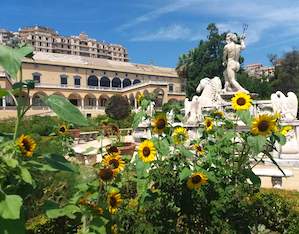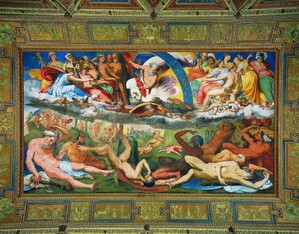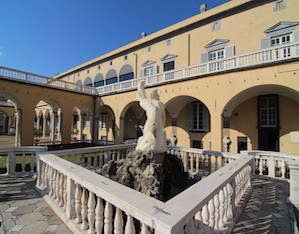Commissioned in 1528 by great Admiral Andrea Doria, the palazzo and its gardens look out from terraces over the sea, forming an ensemble of art and architecture that is one of Genoa’s foremost monumental complexes.
Perin del Vaga, who worked with Raphael, was commissioned to make the initial design for Andrea Doria’s princely residence and the palazzo’s rich decorations. Work on the first phase of the garden continued until 1548. Work was resumed in 1578 by Doria’s heir, Giovanni Andrea I, who commissioned Giovanni Ponziello to build loggias overlooking the sea. Over the next century, the complex underwent so many modifications that its appearance was greatly changed. In the 1760s, the complex went into decline. In the mid-19th century, the “uphill garden” was demolished during building of the Genoa-Turin railway. Around this time, Filippo Andrea V Doria Pamphilj and his wife Mary Talbot converted what was left of the garden into an “English-style” garden. In 1944, the complex suffered considerable damage from bombardment. Recent restoration (1998-2000) has salvaged some of the garden’s 16th-century structure, which was better documented than other periods and built to reflect the building’s architecture. At the front, it consists of three parterresof which the main one, divided into formal and symmetrical compartments, is laid out around a “Fountain of Neptune” – the focal point of the entire arrangement. A smaller parterre in the easternmost portion of the courtyard surrounds the older “Dolphin Fountain”.
Highlights

The “Fountain of Neptune”
Made by Taddeo Carlone at the end of the 16th century, the fountain depicts the god of the sea at the head of a shell-shaped chariot pulled by three sea horses in the centre of a twelve-sided pool decorated with eagles that clutch snakes and sea monsters in their talons.

Palazzo Decorations
Genoa’s largest aristocratic residence, the Villa’s refined decoration, created by Perin del Vaga between 1529 and 1533 with artistic innovations developed in Rome, celebrates the personage of Andrea Doria, incorporating surprising effects such as the “Hall of the Giants”.

The “Dolphin Fountain”
Crafted by Silvio Cosini to a Perin del Vaga design, this fountain features a series of overlapping basins decorated with griffins, putti and dolphins; a sculptural group of a triton on a dolphin, by Giovanni Angelo Montorsoli, was added in around 1540.
 Villa Andrea Doria
Contacts
Villa Andrea Doria
Contacts
 Villa Andrea Doria
Opening times and prices
Villa Andrea Doria
Opening times and prices
Opening hours
From Sunday 26th July Villa del Principe will have the following opening hours:
– Monday to Friday from 10:00 am to 5:00 pm (last entry 4:15 pm)
– Saturday from 10:00 am to 3:00 pm (last entry at 2:15 pm)
– SUNDAY CLOSED
The garden can be visited on payment and with a guided tour from Monday to Wednesday.
For information and reservations please call +39 010 255509 or e-mail.
Pricing
Full price € 9,00
Reduced € 7,00 (Students up to 26 years old, Over 65, FAI Members, Touring Club Members, Coop Members)
Free admission (children up to 6 years old, journalists with ID)
 Villa Andrea Doria
How to get there
Villa Andrea Doria
How to get there
Address
Piazza del Principe, 4
16124, Genova (GE)
Latitude: 44.4168845
Longitude: 8.9080796
How to arrive by road
Four highways from different points connect the city to the national network:
-
A12 Genova – Rosignano, to and from Levante exit GE Nervi and GE Est
-
A26 Voltri – Gravellona, links up with the A10 at Voltri
-
A10 dei Fiori, Genova – Ventimiglia, for the Ponente, exits GE Voltri – GE Pegli – GE Aereoporto – GE Ovest
-
A7 Serravalle, Genova – Milano, exit GE Bolzaneto – Genova Ovest
How to arrive by train
The villa is 100 metres from Genoa Piazza Principe Train Station.
 Villa Andrea Doria
Services/Accessibility
Villa Andrea Doria
Services/Accessibility
Services
At the ticket office of the Villa there is a bookshop, open every day from 10.00 am to 6.00 pm. For information contact Mr. Davide Cerrara at +39 010 255509 or write to [email protected]
- Groups can visit the main floor of the Villa and its wonderful Italian garden. To make the visit even more interesting, it is possible to agree in advance with the guides themed visits or special insights, related to aspects or events in the history and works of the Villa that are of greatest interest. For further information [email protected] or +39 010 255509.
- To enjoy a totally exclusive experience you can book a private guided tour that will take place when the museum is closed and will allow visitors to enjoy the beauty of the Villa in a unique atmosphere. For info and rates write to [email protected] or call +39 010 255509.
Didactics for schools
- The fee for the educational tours is € 7.00 per student and includes the guided tour.
- The fee for the garden workshops is € 5.00 per student and includes the guided tour.
- For educational tours in the museum: every day from 10.00 am to 6.00 pm. Last admission at 5.00 pm.
- For garden workshops: Monday to Friday from 10.00 am to 1.00 pm.
 Villa Andrea Doria
Private events
Villa Andrea Doria
Private events
 Villa Andrea Doria
Itineraries
Villa Andrea Doria
Itineraries
You could find the garden in these itineraries
 Favorite saving result
Favorite saving result
 Warning!
Warning!
You've have to sign up or sign in to add this element to your favorites.
